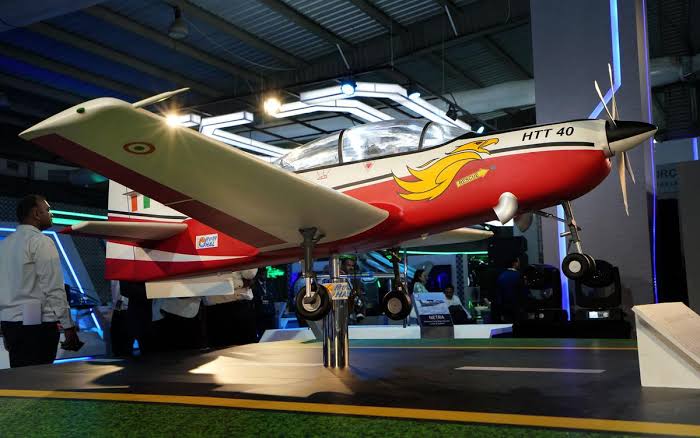IAF to get 70 HTT40 Aircrafts worth ₹6,800 Crore, Renewed effort on IJT

A Rs 6800 Crores deal was contracted between the MoD and the HAL on Thursday for 70 HTT-40 indigenous Basic Trainer Aircraft (BTA). In August 2020, the Defence Acquisition Council (DAC) had approved the procurement of 106 HTT-40 for the IAF of which post certification 70 BTA will be initially procured from the HAL and balance 36 after operationalisation of HTT-40 training fleet in the IAF.
HAL received the Request For Proposal from the IAF for HTT-40 for 70 aircraft in Feb2021 at Aero India show, with additional clause for 38 more. Production will take place at HAL’s two manufacturing units at Bangalore and Nasik.
The IAF pilots used to do their first stage of training on HAL manufactured Hindustan Piston Trainer-32 (HPT-32). The aircraft was grounded in 2009 following several crashes and engine failures. That is when the IAF went in for the Pilatus from Switzerland for 75 aircraft.
In its 2019 report, the Comptroller and Auditor General of India (CAG) was critical of the Rs. 2,895.63 crore Pilatus deal, saying that incorrect price calculations had worked in the firm’s favour. The audit report said that the Switzerland-based Pilatus Aircraft got the deal despite failing to commit to transfer of technology for maintenance, and was allowed to tweak its offer at a later stage for an advantage over competitors. The firm also didn’t offer a seamless supply of spares, it added.
The 2012 deal has been under the scanner of the Central Bureau of Investigation (CBI) since it was flagged by the defence ministry while it was under Manohar Parrikar. However, in January 2016, the Defence Acquisition Council (DAC) approved the procurement of 38 PC-7 MK-II trainers from the Swiss company after a strong pitch from the IAF.
The government then cancelled the proposed deal for additional Pilatus aircraft in 2019, after the HTT-40 cleared crucial trials. However, suspension of business with Pilatus affected the maintenance of the existing fleet since spare parts were unavailable. Sources said the IAF was forced to source spare parts from third part sources and also cannibalise existing aircraft.
Now the purchase of 70 Hindustan Turbo Trainer (HTT)-40 trainer aircraft, will reduce the pressure off the IAF which is juggling its training modules due to limited number of planes.
The above takes care of basic flying training at stage 1. The stage 2 training is still continuing with teaching Kiran IJT16. Thus the next step for the IAF is the Intermediate Jet Trainer (IJT) 36 which will replace the ageing Kiran aircraft used for Stage 2 of training.
Both Stage 1 and Stage 2 of training last for six months each before the pilots move onto the next stage for advanced training which is for about one year on the Hawk jets.
Due to the depleting number of trainers, the IAF was forced to use limited numbers of Kiran and even Pilatus for Stage 2 of training. It was in January that the IAF pilots successfully demonstrated the IJT36 ’s capability to carry out six turn spins to the Left Hand and Right Hand sides.
Though the IJT had completed demonstration of its capabilities in terms of altitude and speed envelope, load factor, satisfactory stall characteristics and limited armament capability as required by the IAF much earlier, successful spin test was pending.
During spin testing in 2016, the aircraft departed from controlled flight which brought the program to a temporary halt, the HAL had said in a statement, adding that it decided to proceed further using its internal resources to complete the critical spin testing.
Once IJT36 enters service then IAF will be self sufficient in matters of all stages pilot training.
In addition to HTT40 , In all, 451 Memoranda of Understanding (MoU), Transfer of Technology (ToT) agreements and product launches also took place during the Bandhan ceremony at the 12th DefExpo.
There were 345 MoUs, 42 major announcements, 46 product launches and 18 ToTs. The contribution of Gujarat was 28 MoUs and one product launch. It envisages investment worth ₹1.5 lakh crore.
Speaking at the event, which marked the end of three business days of the Expo, Defence Minister Rajnath Singh a strong and prosperous ‘New India’ is fully ready to stand shoulder-to-shoulder with major world powers. “Our self-reliance efforts are to ensure that the nation and its people remain protected from future threats,” he stated.
Earlier the Defence Ministry held an event ‘Invest for Defence’ meant to promote investment in the defence sector in the country both by the Indian industry as well Foreign Original Equipment Manufacturers.
During the discussion, Adani Defence & Aerospace projected investments to the tune of ₹5,000 crores in priority areas of information processing, Artificial Intelligence, Unmanned systems among others. Adani Group also announced a plan to set up the largest Maintenance and Repair Operations (MRO) facility to cater to both defence and civil areas.
Lockheed Martin shared its plans for establishing MRO and Multi Role Fighter Aircraft facilities in the country and integrating local manufacturers into the global supply chain while SAAB India announced that it is planning to commence production of Karl-Gustaf launchers in India by 2024.



